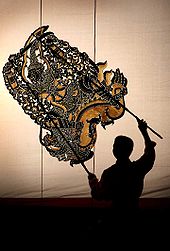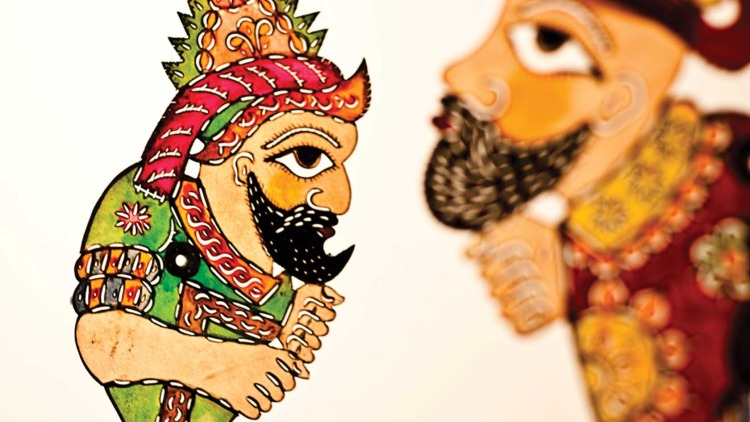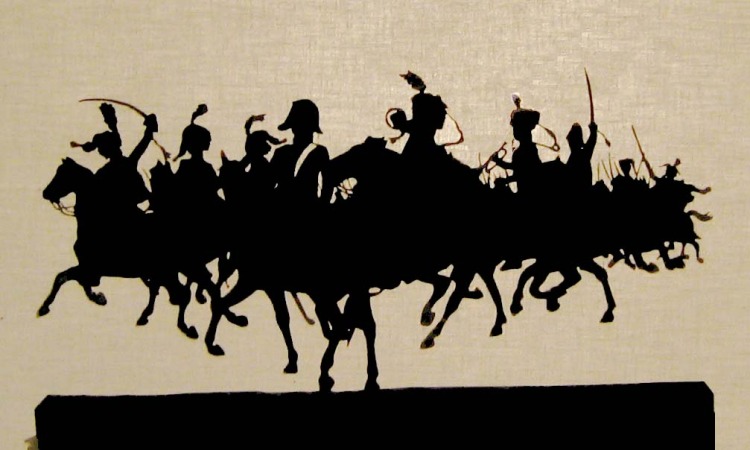Shadow Play is the first installment of our series ‘Exploring the History and Identity of Vintage‘, in which we will be covering various topics and interesting themes.
Shadow play, or as otherwise known, shadow puppetry, is ancient old form of entertainment and storytelling that would present tales, myths, legends and even war events to it’s spectators. The success and popularity of this form of theater partially lies on the simplicity of it’s medium: flat articulated figures are used against a translucent screen and to depict movement, light is shed from behind the screen. Even though great skill is needed to perform almost all kinds of shadow puppetry, the simplicity of materials and set up needed has made it possible for talented puppeteers to entertain even the poorest of a society’s citizens.
Shadow puppetry is present in many cultures and today there are more than 20 countries known to have shadow show troupes. Shadow play is an old tradition and appears to have deep roots in Southeast Asia, especially in Indonesia, Malaysia, Thailand and Cambodia. It is also considered and ancient form of art in China, India and Nepal. In the West, shadow play is mostly prominent in Turkey, Greece and France.
There are many differences in shadow plays between different countries. Different materials are used for puppet construction, the puppets themselves show huge variations in appearance and detailing, while the content is usually similar for neighboring countries but completely different for those far apart.
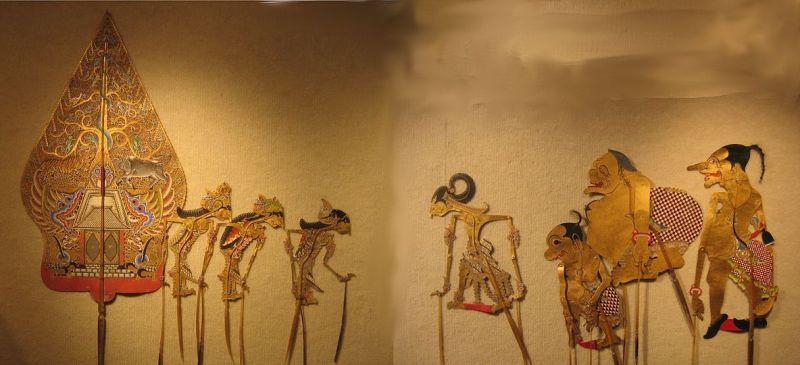
Wayang (shadow puppets) from central Java, a scene from Irawan’s Wedding, mid 20th century, University of Hawaii Dept. of Theater and Dance.
Indonesia
In Indonesia, shadow puppet theater is called Wayang kulit and it enjoys particular popularity in Java and Bali. The word Wayang means shadow or imagination in Javanese and also connotes “spirit”. Kulit means skin and it is the material from which the puppet is usually made. Thin perforated leather sheets made from buffalo skin is today the preferred option. Other puppets were made from wood (Wayang klitik), but because battle scenes frequently caused irreparable damages to the arms, substitution of wood by skin gradually took place. The handle of the rod is also made of carved buffalo horn.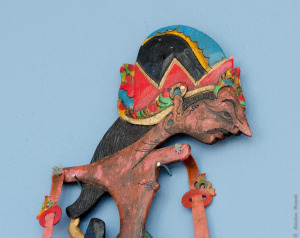
In Java, performances are commonly accompanied by a gamelan. In Bali plays originally last as long as six hours or until dawn. The complete Wayang Kulit troupes include a Dalang (puppet master), the Nayaga (gamelan players) and a Sinden (female choral singer). Some of the nayaga can also perform as a male choral singer. The dalang (puppet master) plays the wayang behind the cotton screen illuminated by oil lamp or modern halogen lamp, creating visual effects similar to animation. The flat puppets have moveable joints that enable their animation by hand, using appropriately connected rods.
The shadow plays are invariably based on romantic tales, especially adaptations of the classic Indian epics, the Mahabharata and the Ramayana. Some of the plays are also based on local happening or other local secular stories. It is up to the conductor or dalang or master puppeteer to decide his direction.
Wayang today is both the most ancient and most popular form of puppet theatre in the world. Hundreds of people will stay up all night long to watch the superstar performers, dalang, who command extravagant fees and are international celebrities. Some of the most famous dalang in recent history are Ki Nartosabdho, Ki Anom Suroto, Ki Asep Sunandar Sunarya, Ki Sugino, and Ki Manteb Sudarsono. (via)
On November 2003, UNESCO deisgnated Wayang Kulit as one of the ‘Masterpieces of the Oral and Intanglible Heritage of Humanity’.
Thailand
Shadow theater in Thailand is called Nang Yai; in the south there is a tradition called Nang Talung. The term Nang Yai means ‘large shadow puppet’ and the puppets themselves are made of cowhide and rattan. Performances are traditionally held in open spaces, such as a lawn or village dirt space, while being accompanied by a combination of songs and chants.
As a form of high art it originates at the beginning of the 15th century [CE]. Nang Yai was a popular kind of entertainment during the Ayudhaya period and is mentioned in a poem called Bunnovat Khamchan written by the Buddhist monk Mahanag sometime between the years 1751-1758 CE, at the end of King Boromakot’s reig. It is considered to be the source of modern mask dance and it incorporates various episodes of an Indian epic called Ramakien in Thai and Ramayana in India. Nang Yai shadow plays also adopt the Ramayana as a leading story and the performance is episodic in each show.
Performances in Thailand were temporarily suspended in 1960 due to a fire at the national theatre. Nang drama has influenced modern Thai cinema, including filmmakers like Cherd Songsri and Payut Ngaokrachang.
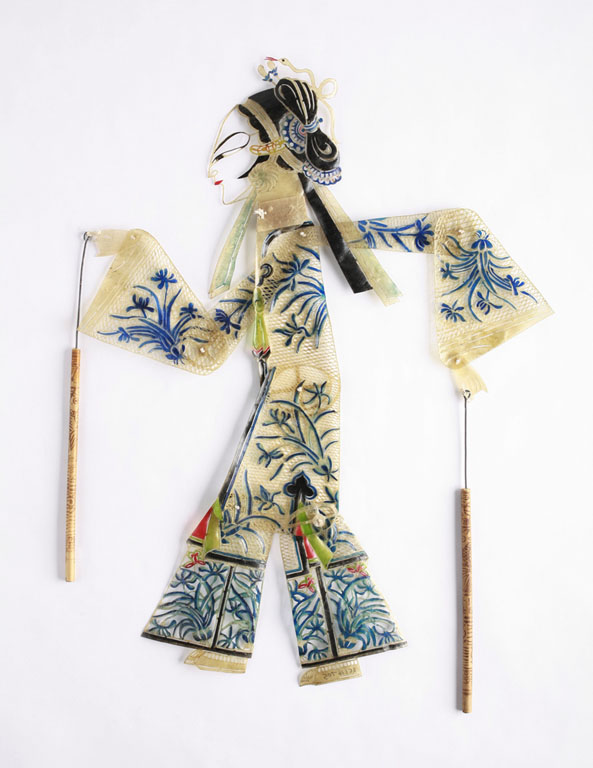
This Chinese shadow puppet is illustrative of the ornate detail that goes into the figures. In the collection of The Children’s Museum of Indianapolis.
China
Shadow play appeared in China during the Han Dynasty, when one of the concubines of Emperor Wu of Han died from an illness. The emperor was devastated and he summoned his court officers to find a way to bring his beloved back to life. The officers constructed a figure in the shape of the concubine using donkey leather. Her joints were animated using 11 separate pieces of the leather, and adorned with painted clothes. Using an oil lamp they made her shadow move, bringing her back to life.
Chinese shadow theater became rather popular as early as the Song Dynasty, when historically, holidays were marked by the presentation of many shadow plays. One could find 40 to 60 shadow troupes in the city of Beijing alone, during the Ming Dynasty.
In the 13th century, even among the Mongolian troops, shadow puppetry became a regular form of entertainment. It was spread by the conquering Mongols to distant countries like Persia, Arabia, and Turkey. Later, it was introduced to other Southeastern Asian countries. The earliest shadow theater screens were made of mulberry paper. The storytellers generally used the art to tell events between various war kingdoms or stories of Buddhist sources. Today, on the other hand, puppets are made out of leather and the stories usually evolve around dramatic versions of traditional fairy tales and myths.
Today, puppets are made of leather and moved on sticks are used to tell dramatic versions of traditional fairy tales and myths. In the Gansu province, performances are accompanied by Daoqing music, while in Jilin, accompanying Huanglong music forms some of the basis of modern opera.
Chinese shadow puppetry is shown in the 1994 Zhang Yimou film To Live.
Turkey
The Turkish tradition of shadow play is called Karagöz and Hacivat, was particularly widespread throughout the Ottoman Empire and featured characters representing all of the major ethnic and social groups in that culture. It was performed by a single puppet master, who voiced all of the characters and accompanied by a tambourine (def). It’s origins are obscure, though it is very likely that it migrated from an Asian source.
Karagöz (‘blackeye’ in Turkish) and Hacivat (shortened from ‘Hacı İvaz’ meaning ‘İvaz the Pilgrim’) are the lead characters of the traditional play, popularized during the Ottoman period and was most prominently presented in Turkey and Greece. They are the characters whose contrasting interaction shapes the central theme of the plays.
They are perfect foils of each other: in the Turkish version, Karagöz represents the illiterate but straightforward public, whereas Hacivat belongs to the educated class, speaking Ottoman Turkish and using a poetical and literary language. Although Karagöz has definitely been intended to be the more popular character with the Turkish peasantry, Hacivat is always the one with a level head. Even though Karagöz always outdoes Hacivat’s superior education with his ‘native wit’, he is also very impulsive. His never-ending deluge of get-rich-quick schemes always results in failure.
Other characters in these plays are the drunkard Tuzsuz Deli Bekir with his wine bottle, the long-necked Uzun Efe, the opium addict Kanbur Tiryaki with his pipe, Altı Kariş Beberuhi (an eccentric dwarf), the half-wit Denyo, the spendthrift Civan, and Nigâr, a flirtatious woman. There may also be dancers and djinns, and various portrayals of non-Turks: an Arab who knows no Turkish (typically a beggar or sweet-seller), a black servant woman, a Circassian servant girl, an Albanian security guard, a Greek (usually a doctor), an Armenian (usually a footman or money-changer), a Jew (usually a goldsmith or scrap-dealer), a Laz (usually a boatman), or an Iranian (who recites poetry with an Azeri accent).
Karagöz-Hacivat plays are especially associated with the Ramadan. Until the rise of radio and film, it was one of the most popular forms of entertainment in Turkey.
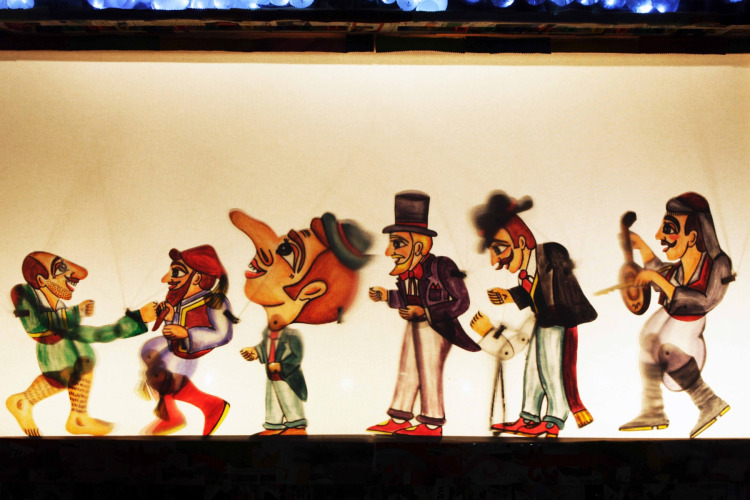
Karagiozis: Greek shadow theater characters.
Greece
The Greek version of shadow play is called Karagiozis or Karaghiozis (Modern Greek: Καραγκιόζης) which is mainly derived from the the Turkish play of Karagöz and Hacivat.
Prevailing theories suggest that shadow puppetry came to mainland Greece from Asia Minor (Anatolia) in the 19th century, during the Ottoman rule. Karagiozis was hellenized in Patras by Dimitrios Sardounis (also commonly known as Mimaros), who is considered to be the founder of modern Greek shadow theater. Mimaros removed phallic elements and obscene language, characteristic of the Turkish Karagöz, and relocated the performances from the cafes to the hub of urban life, the parks and squares of major cities.
Karagiozis is depicted as a poor hunchbacked Greek, his right hand is always long, his clothes rugged and patched and his feet always bare. He lives in a poor cottage (Greek: παράγκα) with his wife Aglaia and his three sons, during the times of the Ottoman Empire. The theater scene sheet is traditionally occupied by his cottage on the left and the Sultan’s Palace (Sarayi) on the far right. Because of his poverty, Karagiozis uses mischievous and crude ways to find money and feed his family.
Students of folklore divide Karagiozis’ tales in two major categories: the ‘Heroics’ and the ‘Comedies’. The Heroics are tales based on tradition or real stories occurring in the times under Ottoman rule. Karagiozis is then presented as an assistant to an important hero.
France
Shadow play arrived in France around 1767 with French missionaries returning from China. It began to spread in the mid-18 century and had gained considerable popularity by the end of the 19th century. The first performances of shadow play were held in Paris and Marseilles, causing quite a stir. The Ombres chinoises (French for “Chinese Shadows”) with local modification and embellishment, became the Ombres françaises and struck root in the country.
This form of entertainment was popular in the nightclub district of Montmartre. The cabaret Le Chat noir (“The Black Cat”) produced a number of popular Ombres chinoises shows in the 1880s, organized by the artist Henri Rivière, using up to 20 assistants and a large, oxy-hydrogen back-lit performance area. The Ombres evolved into numerous theatrical productions and had a major influence on phantasmagoria.
Today, there are several theater companies that honor this exquisite form of art and are still developing the practice of shadow puppets. Namely, these include the: Le Théâtre des Ombres, Le Théâtre du Petit Miroir, Le Théâtre Les Chaises, and La Loupiote.
References & further reading:
- [1]: http://en.wikipedia.org/wiki/Shadow_play
- [2]: http://www.portesmagazine.com/2014/06/03/arts-culture-karagiozis-greeces-iconic-character/
- [3]: http://www.triptod.com/News/42/Shadow-Play-Around-the-World.html
- [4]: http://www.chineseshadowpuppetry.com/
- [5]: http://www.karagoz.net/english/shadowplay.htm
- [6]: http://www.britishmuseum.org/explore/highlights/highlight_objects/asia/s/shadow_puppet-1.aspx
- [7]: http://en.wikipedia.org/wiki/Karag%C3%B6z_and_Hacivat
- [8]: http://en.wikipedia.org/wiki/Karagiozis

